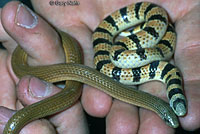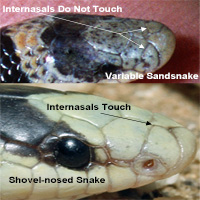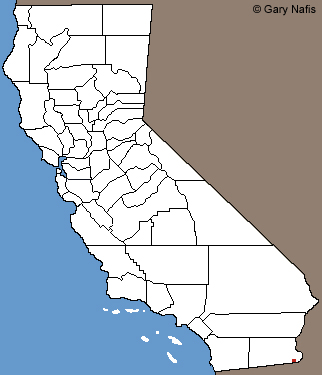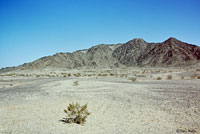|
Possibly occurring in California
 |
 |
 |
| Adult, Baja California del Sur |
Adult, Baja California del Sur |
Adults of two pattern types,
Baja California del Sur |
|
 |
|
Reported habitat just west of the Colorado River,
near the Algodones dunes, Imperial County |
|
| |
|
| Similar Snakes |
Comparison chart of the 3 subspecies of Chionactis in California,
along with the similar sympatric species - Sonora semiannulata,
and the similar possibly sympatric species - Chilomeniscus stramineus.
|
 |
 |
|
|
| Description |
Not Dangerous - This snake does not have venom that can cause death or serious illness or injury in most humans.
Commonly described as "harmless" or "not poisonous" to indicate that its bite is not dangerous, but "not venomous" is more accurate. (A poisonous snake can hurt you if you eat it. A venomous snake can hurt you if it bites you.)
|
| Size |
One of the smallest Southwestern U.S. snakes: adults 7 - 11 inches (17.8-28 cm).
|
| Appearance |
A small rounded snake with smooth, unkeeled, shiny scales, a narrow head, a flat snout, nasal valves, counterset lower jaw, small upturned eyes, and a concave abdomen.
The internasal scales are separated by large rostal scales.
|
| Color and Pattern |
Black or brown dorsal saddles on the back, usually completely encircle the body on the short, stout tail.
Ground color is cream, yellowish, or reddish orange to strawberry.
Cream to pale yellow abdomen.
|
| Life History and Behavior |
Activity |
Active at night, or during heavy rains, seldom surfacing during the day. A good and persistent burrower. Smooth scales, flat shout, concave abdomen, and nasal valves are adaptations that allow for a quick swimming movement through loose sand.
Commonly found on desert roads on hot summer nights. |
| Diet and Feeding |
| Eats invertebrates, including grasshoppers, cockroaches, and centipedes, often foraging just under the surface of the sand. |
| Reproduction |
Females are oviparous.
Wild snakes have been found gravid with eggs in June and July.
|
| Possible Occurance in California |
The possibility of Chilomeniscus turning up in suitable habitat west of the Colorado River where it occurs in Arizona and Baja California, and personal communications with an amateur herpetologist experienced with the species who claims to have found it near the Algodones Dunes, have led me to include the species as possibly occurring in Calfiornia.
Grinnell and Camp, 1917, indicate that there are two records for the snake in California:
Owens Valley, Inyo County, and Fort Yuma, Imperial County
Philip Brown, in his 1997 guide to California Snakes * states that he did not include Chilomeniscus in his book because there are no specimens of this snake in the major museum collecitions and because eminent scientists and collectors have failed to find it in California. However, he mentions that some people still feel that it could be present in the Algodones Dunes or Winterhaven area.
The history of Chilomeniscus in Calfornia, according to Brown:
In 1861 Edward Drinker Cope in 1861 described a new species of Chilomeniscus which was collected by Dr. George H. Horn from the Owens Valley. In 1917, Grinnell and Camp mention two specimens of Chilomeniscus that were collected in California. One was the Owens Valley specimen, the other was a mutilated specimen which they found near Fort Yuma California. Chilomeniscus showed up in some sources as present in California, including Wright and Wright, 1957, and Schmidt and Davis, 1953, but Stebbins did not include it in his guides in 1954, 1966, and 1985. In 1963, Banta and Leviton, who did a study on the genus Chilomeniscus, concuded that the Owens Valley specimen was "probably in error."
* Brown, Philip R. A Field Guide to Snakes of California. Gulf Publishing Co., 1997, pp. 180 - 181.
|
| Habitat |
Dry deserts with sand or loamy soil, including sandy or gravelly washes, creosote bush flats, arroyos, and areas grown with mesquite and saguaro, and ocotillo.
|
| Geographical Range |
Found in southwestern Arizona, south along the coast into Mexico, and throughout much of Baja California.
|
 |
| Notes on Taxonomy |
Cox et al in their April 2018 paper "Synopsis and taxonomic revision of three genera in the snake tribe Sonorini," synonymized genera Chilomeniscus and Chionactis with genus Sonora. They did not discuss common names changes.
If their taxomomy is accepted:
* Sonora semiannulata semiannulata becomes Sonora semiannulata;
* Chionactis occipitalis becomes Sonora occipitalis;
* Chionactis annulata annulata becomes Sonora occipitalis;
* Chilomeniscus stramineus, where possibly present in California, becomes Sonora cincta.
(Synopsis and taxonomic revision of three genera in the snake tribe Sonorini.
Christian L. Cox, Alison R. Davis Rabosky, Iris A. Holmes, Jacobo Reyes-Valasco, Corey E. Roelke, Eric N. Smith, Oscar Flores-Villela, Jimmy A. GcGuire and Jonathan A. Campbell.
Journal of Natural History, 2018 Vol. 52, Nos. 13-16, 945-988.
https://doi.org/10.1080/00222933.2018.1449912)
--------------------------------------------------------------------------------------------------------------------------------------------------------------------
Grismer et al. (2002 Herpetologica 58: 18-31) found Chilomeniscus cinctus, C. punctatissimus, and C. stramineus to represent morphotypes of a single species.
Alternate and Previous Names (Synonyms)
Chilomeniscus cinctus - Variable Sand Snake (Stebbins 2003)
Chilomeniscus cinctus - Banded Sand Snake (Stebbins 1954, 1966, 1985)
Chilomeniscus cinctus - Banded Burrowing Snake (Chilomeniscus ephippicus. Horse Snake; Red and Black Ground Snake) (Grinnell and Camp 1917)
Chilomeniscus cinctus (Cope 1861)
Burrowing snake
Arizona ground snake
Sonora ringed snake
Formerly known as Chilomeniscus cinctus - Banded Sand Snake
Variable Sand Snake
Chilomeniscus stramineus Western Sand Snake
|
| Conservation Issues (Conservation Status) |
| None |
|
| Taxonomy |
| Family |
Colubridae |
Colubrids |
| Genus |
Chilomeniscus |
Sandsnakes |
Species
|
stramineus |
Variable Sandsnake |
|
Original Description |
Chilomeniscus - Cope, 1860 - Proc. Acad. Nat. Sci. Philadelphia, Vol. 12, p. 339
(Chilomeniscus cinctus Cope, 1861 Banded Sand Snake)
Chilomeniscus stramineus - Grismer, et al. (2002, Herpetologica 58:18-31)
from Original Description Citations for the Reptiles and Amphibians of North America © Ellin Beltz
|
|
Meaning of the Scientific Name |
Chilomeniscus - Greek - cheilos - margin, lip or brim and Greek - meniskos - little moon or crescent == ref. shape of the rostral scale
(cinctus - Latin - belted, girdled -- ref. body bands)
from Scientific and Common Names of the Reptiles and Amphibians of North America - Explained © Ellin Beltz
stramineus - Latin - stramin - straw, made of straw
from Jaeger, Edmund C. A Source-book of Biological Names and Terms Third Edition. Charles C. Thomas Publisher, 1962.
|
|
Related or Similar California Snakes in the Same Potential Habitat |
C. a. annulata - Colorado Desert Shovel-nosed Snake
S. s. semiannulata - Variable Groundsnake
|
|
More Information and References |
California Department of Fish and Wildlife
Hansen, Robert W. and Shedd, Jackson D. California Amphibians and Reptiles. (Princeton Field Guides.) Princeton University Press, 2025.
Stebbins, Robert C., and McGinnis, Samuel M. Field Guide to Amphibians and Reptiles of California: Revised Edition (California Natural History Guides) University of California Press, 2012.
Stebbins, Robert C. California Amphibians and Reptiles. The University of California Press, 1972.
Flaxington, William C. Amphibians and Reptiles of California: Field Observations, Distribution, and Natural History. Fieldnotes Press, Anaheim, California, 2021.
Samuel M. McGinnis and Robert C. Stebbins. Peterson Field Guide to Western Reptiles & Amphibians. 4th Edition. Houghton Mifflin Harcourt Publishing Company, 2018.
Stebbins, Robert C. A Field Guide to Western Reptiles and Amphibians. 3rd Edition. Houghton Mifflin Company, 2003.
Behler, John L., and F. Wayne King. The Audubon Society Field Guide to North American Reptiles and Amphibians. Alfred A. Knopf, 1992.
Powell, Robert., Joseph T. Collins, and Errol D. Hooper Jr. A Key to Amphibians and Reptiles of the Continental United States and Canada. The University Press of Kansas, 1998.
Bartlett, R. D. & Patricia P. Bartlett. Guide and Reference to the Snakes of Western North America (North of Mexico) and Hawaii. University Press of Florida, 2009.
Bartlett, R. D. & Alan Tennant. Snakes of North America - Western Region. Gulf Publishing Co., 2000.
Brown, Philip R. A Field Guide to Snakes of California. Gulf Publishing Co., 1997.
Ernst, Carl H., Evelyn M. Ernst, & Robert M. Corker. Snakes of the United States and Canada. Smithsonian Institution Press, 2003.
Taylor, Emily. California Snakes and How to Find Them. Heyday, Berkeley, California. 2024.
Wright, Albert Hazen & Anna Allen Wright. Handbook of Snakes of the United States and Canada. Cornell University Press, 1957.
Joseph Grinnell and Charles Lewis Camp. A Distributional List of the Amphibians and Reptiles of California. University of California Publications in Zoology Vol. 17, No. 10, pp. 127-208. July 11, 1917.
|
|
|
The following conservation status listings for this animal are taken from the April 2024 State of California Special Animals List and the April 2024 Federally Listed Endangered and Threatened Animals of California list (unless indicated otherwise below.) Both lists are produced by multiple agencies every year, and sometimes more than once per year, so the conservation status listing information found below might not be from the most recent lists. To make sure you are seeing the most recent listings, go to this California Department of Fish and Wildlife web page where you can search for and download both lists:
https://www.wildlife.ca.gov/Data/CNDDB/Plants-and-Animals.
A detailed explanation of the meaning of the status listing symbols can be found at the beginning of the two lists. For quick reference, I have included them on my Special Status Information page.
If no status is listed here, the animal is not included on either list. This most likely indicates that there are no serious conservation concerns for the animal. To find out more about an animal's status you can also go to the NatureServe and IUCN websites to check their rankings.
Check the current California Department of Fish and Wildlife sport fishing regulations to find out if this animal can be legally pursued and handled or collected with possession of a current fishing license. You can also look at the summary of the sport fishing regulations as they apply only to reptiles and amphibians that has been made for this website.
There are no significant conservation concerns for this animal in California.
|
| Organization |
Status Listing |
Notes |
| NatureServe Global Ranking |
|
|
| NatureServe State Ranking |
|
|
| U.S. Endangered Species Act (ESA) |
None |
|
| California Endangered Species Act (CESA) |
None |
|
| California Department of Fish and Wildlife |
None |
|
| Bureau of Land Management |
None |
|
| USDA Forest Service |
None |
|
| IUCN |
|
|
|
|
 Red: Possible Range in California
Red: Possible Range in California








